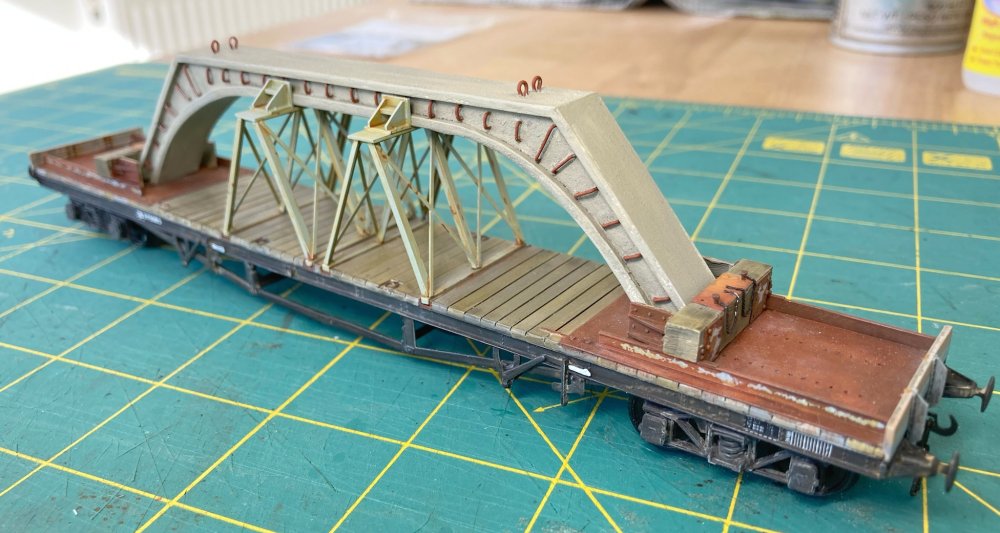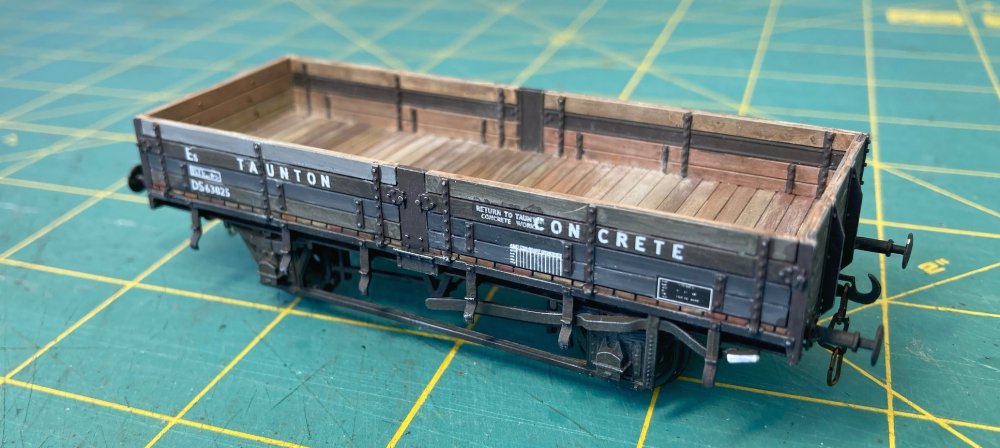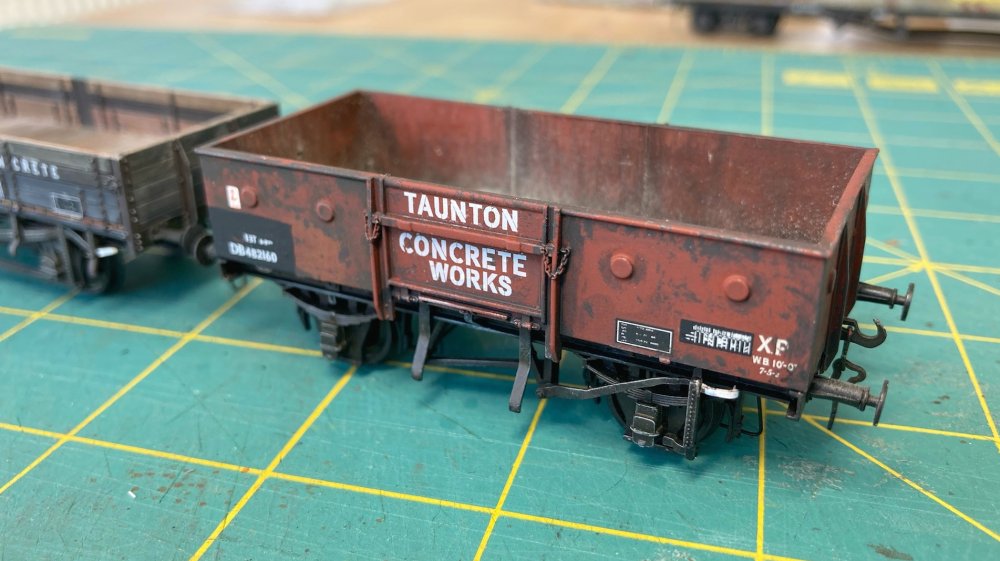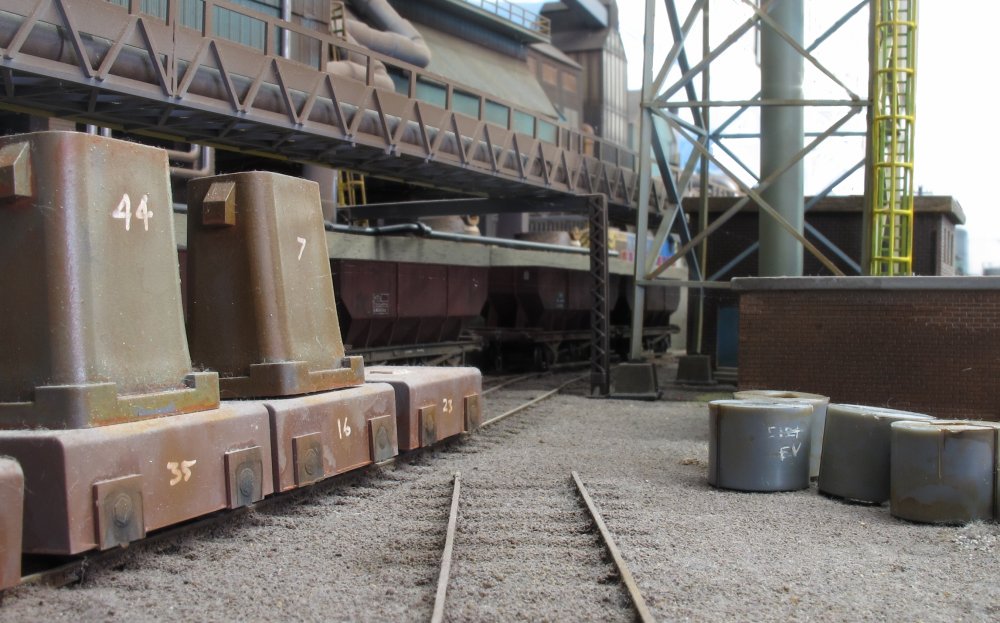This is a little different - it's the 10ft wheelbase 16 ton mineral wagon rebuilt on
ex-Palbrick chassis. As a result the body is a foot longer than the standard 16 ton version.
There were variations with the brakegear depending on the version of Palbrick used. Some
wagons were further rebuilds of of Coil wagon conversions from Palbricks, so some of them
had interesting histories.
I've also been revisiting some of my earlier designs to include extra detail, now I know what
level of detail resin printing is capable of in 4mm scale. Initially when I started off with a
filament printer, small detail such as rivets weren't possible to reproduce. I was kindly sent
a photograph of a Weltrol Dia 2/733 in BR days, the first such picture I've seen of this type
which showed a view of the brakegear, so I've updated the drawings for a more accurate model.
As always, these and all the other designs are available for free download at
Thingiverse
*********************************************************************************************************************************************

STEVE CARTER

The two outer boards have now been fitted to the layout which will enable the planning of
track and scenic elements to get underway. The two outer boards (A and F) are equipped
with four legs each as per the central block of two (C & D). Boards B and E are sandwiched
between the three supported blocks so do not require support legs. The new structures
follow the previous methods of construction but do not require any diagonal bracing, the
whole system being sufficiently sturdy.

Not exactly a high tech approach but simply adding cardboard blocks as visual aids gives
an overall sense of what works and what doesn't. Block A will represent a factory which has
expanded its foot print by building new block C and linking the two by means of a covered
walkway B. Blocks D and E will be terraced housing whilst block F will be a school, the
latter being chosen to allow an open view across the yard.

Flexible grey plastic strips (rescued from a scrapped aluminium door frame) were joined
together and mounted in the manner shown. Clamping the wooden bracket allows it to be
moved left or right whilst the strips can be pushed inwards or outwards within it thus
allowing the plotting of a variable transition curve running between the entry and exit
points of the scenic section.

The central section of the layout will be dominated by a former four storey cotton mill
(denoted by A) which has undergone changes for a new industrial role. External lift shafts
(B) are added which feed onto a loading dock (C) below which can accommodate six 12T Vent
Vans for loading / unloading. A head shunt and small run round loop are incorporated and
the opposite side of the loading dock will be available for use by road vehicles. The area
denoted by D is the school yard whist E is to be yet more terraced housing.

The inspiration for the cotton mill is provided by Western Mill No. 3 which was part of
the Eckersley manufacturing complex located in Wigan (the 17 acre site is soon to be
redeveloped with Mill No. 3 scheduled to become residential accommodation). Numerous
reference pictures have been taken and the building has been measured up to reveal a
4mm scale version will measure 1066 (l) x 412 (w) x 257 (h)mm.

The left hand end scenic section - A is to be a LNWR type 4 signal box built in a raised
fashion to allow a view over Bridge C which carries the access road for the mill /
industrial factory area over the tracks. Block B is another row of terraced housing and
D may become some sort of ancillary building for the former mill. Lines 1 and 2 are the
main running lines and form a junction with lines 3 and 4, these being a former double
tracked passenger line which has now become a single freight only line serving one or two
customers. Line 5 leaves this single line and is the siding serving the mills loading dock.

The design for the road bridge is inspired by this former bridge that takes the A573
Warrington - Wigan road across the tracks of the former New Springs Branch. It was this
bridge that proved to be problematic when delivering withdrawn locomotives to the nearby
depot for component recovery as a 17.5t weight restriction prohibited heavy loads from
crossing from the north (the depot entrance being to the left of the shot). The bridge
has since been in-filled but the bridge parapets are still in place (the tracks beyond
now host carriage sidings for servicing Northern rail DMU stock).
*********************************************************************************************************************************************

HYWEL THOMAS

This month has rather a ‘concrete’ theme. Many years back I came
across a couple of wagons numbered in the DB976xxx series. This turned
out to be rather unsuccessful BR series that was intended to comprise
traffic wagons that had been transferred to service use. In the end it
only ran as far as DB976056 but the subject of this model was in a
batch numbered from DB976000-11 and designed to carry concrete beams.
Here is the donor vehicle, a Cambrian Bogie Bolster D, undergoing some
floor modifications.

The floor featured four steel channels designed to hold a pair of
supporting frames for replacement bridge beams. They’re now in place
along with the steel plates over the bogies and u-beams that will
position a pair of hefty wood baulks and new ends. The 12 wagons were
converted at St Rollox in 1971 from a group of ex-LNER Bogie Bolster
Ds and BR standard Boplates, with this example being a former LNER
wagon with diamond frame bogies.

The two bolsters were substantial timber baulks fitted with wood-lined
steel wing plates. They were built from a sandwich of plastic sheet
engraved with a wood pattern. The details were also plastic sheet or
rod. These fit between the u-beams on the steel decks.

This shows both beams in place on the wagon, which has also had a few
further details added. The holes in the floor allowed the baulks to be
moved depending on the length of the beams being carried. The cast
buffers were from 51L.

I think this batch of wagons were probably built to work on the West
Coast electrification project as initially all were allocated to
Newton Heath concrete works on the LMR. A number soon ended up on the
WR working out of Taunton concrete works. This beam, made of card and
foamboard for lightness, was based on photos of typical BR bridge
replacement beams. Here it sits on the wire supports on which the
frame will be built. The weight of the real beam was supported by the
plate end baulks, while these supports only stopped any lateral
movement so didn’t need to be particularly strong.

This is the completed wagon with the support frames of strip built
around the wire armature. Rebar loops and lifting lugs have been added
to the bridge beam, one of two beams that this wagon will be able to
carry on the layout.

The second beam was a simpler straight version, still to have the
rebar added. It sits on the same footprint as the bigger beam, seen
behind, allowing the end baulks to be securely fitted in place. Next
will be priming and then paint.

And here is the completed wagon. Most of the batch were painted in a
simple grey livery with very little lettering although at least one
gained BR olive green paint. This example, DB976005, was one of six
that ended up working out of Taunton and could be found anywhere on
the WR where a bridge replacement project was underway.

This is the wagon carrying the single straight beam, still short of
securing chains as I need some more shackles. The idea is that the
wagon will very occasionally arrive at Morfa Bank for stabling on
behalf of the CCE department at Neath before leaving for the work
site. This will allow me to run it both loaded and empty on the few
occasions it appears.

And here’s the larger, curved beam, complete with support frames, but
again awaiting chains.

Finally, the two beams off the wagon, both simply drop in as required
with no further fixing needed, and are quite stable enough to stay put
while being shunted or moved in a train.

Continuing the concrete theme were two more wagons that formed part of
the Taunton Concrete fleet. This ex-SR Ling was an early transfer and
was used to carry lighter castings to site. It is a stock Chivers
example and, as with all their models, a well-moulded and
straightforward kit to build. The second plank down on this type was a
steel channel, which is why it is painted rusty brown inside.

Another of their fleet, this was a slightly modified Bachmann RTR
example. I think this wagon worked with the similarly lettered sand
tipplers between Stoneycombe Quarry and Taunton. In my scenario it
will be an infrequent visitor, again running with several sand
tipplers, but loading sand for Taunton at Margam, from the nearby dunes.

Finally all three are seen together before entering service on the
layout. None will be regular visitors but they add some nice variety
to the usual traffic found at Morfa Bank. And who can resist some
unusual engineering stock!
*********************************************************************************************************************************************

KIER HARDY

The large area of land at the front of the layout is being developed to feature a selection
of buildings, including a pub, houses and retail premises. The idea has been in at the
planning stage for some time, so a few card buildings were constructed to see how they
would occupy the land, whilst still giving good views of the station.

South Eastern Finecast embossed styrene brick sheet (Flemish bond) has been used for the
public house, mounted on 1.5mm thick styrene sheet. The left hand view shows the walls being
prepared with cut-outs for the windows and corner gussets to keep things square. The right
hand image shows the first and second floor with 3D printed windows test fitted. Vertical
and horizontal strengthening plates will be fitted to prevent any future warping.

The ground floor is shown here under construction, built as a separate module to allow
access for internal detailing of the bar and first floor windows. The position of the
building at the front of the layout warrants internal detail and lighting, especially
as the windows are so large. As well as the windows and doors, other 3D printed detail such
as the external corbels, extractor fans and interior furniture has been produced for this
project, so a big thank you to Jonny Duffett for drawing and printing these items.

A selection of views showing some of the detail work for the pub. I've glued over 250
individual glasses (made from chopped 1mm nylon twine) placed on the tables and the shelves
above the bar, which give a nice prismatic effect from the internal lighting. Double Diamond
printed beer mats at 1.25mm square with triangular ashtrays adorn the tables, and Skol bar
towels in alternate red and yellow are placed at the bar.

There's still more work to be done on this structure which will include a fire escape,
chimneys and downpipes. Some tweaking to the artwork is also required, as I'm not entirely
happy with the distinctive and undernourished pub name font. I used to pass an Ind Coope
pub on the way to school many years ago, and my maternal grandfather worked as a
sales representative for the company in the '60s & '70s - no wonder Long Life keyrings,
Double Diamond penknifes and Skol bar towels could regularly be found around the house!

When the pub is finished it will be bedded into its plot with doorsteps added and a cellar
trapdoor cut into the pavement.

As usual, here's a few snaps taken at other locations around Hornsey Broadway, starting off
with E6018 hauling withdrawn EMU stock, captured on one of the recent running sessions.

A line up of Class 08 shunters at Hornsey Road depot, with D4040 nearest the camera minus
rods en-route to works.

North British Class 22 number D6326 at the head of an inter-regional van train.

A view of the London Transport bus garage yard with a variety of types on show.

Visiting motive power from Paul James Eastwell fleet - 5025 & 5000 on a van train.

This is the new Rapido Hunslet 16" 0-6-0 ST on running trials after conversion to EM gauge,
and will see use on the Woodend Sidings layout for industrial use, destined to carry the
name Greenhaw. At present it represents Jacks Green (Nassington Ironstone) which was
withdrawn from service in 1970 and went to the Nene Valley Railway for preservation.

Greg's ex-works Class 25 in the station as 5025 passes by.

New into the Shenston Road fleet is D6122, a North British Class 21 captured on shed.

Also from Shenston Road is D838 Rapid, rolling into platform 2 on a railtour......

...... waiting for a clear road ahead.......

D838 Rapid heading for East London and then beyond.

A quiet moment at Hornsey Tunnels (it would have to be, standing in the 4ft).
*********************************************************************************************************************************************

MIKE WHITCHURCH

Work this month has been concentrated on the new station extension board, basically 9
straight tracks with bits of platform inbetween. The old bay platform has just simply
been extended, I was thinking of making it a through loop but the radius off of the end
of the board would have been a tad tight and probably restricted its use, so in keeping
with the concept of re-using as much of the original layout as possible, it is now about
a yard longer with a familiar buffer stop on the end.

The existing platforms were Ratio so a few were purchased for the extension, primarily
the ones which were the standard Ratio width as they come out of the packet. With there
being so many (there are 7 platform faces all 4 feet long), it was starting to get expensive
so I constructed my own out of .080” plastic card, the walls being lipped with .040”
square to represent the string course and being covered with SE Finecast block walling
which amazingly exactly matches the Ratio stonework, so to my eye at least they match.

The coping stones were cut from .080” sheet into strips and marked up in a
jig using a Ratio strip to maintain consistency.

The rough The edges were smoothed off in another jig (ps, I like my jigs as it makes things
easier for my ham fisted sausage fingers to do a half decent passable job)! The platform
centres were either the Ratio ones re-used as is, or cut out of .080” again, (anybody who
invested in .080” plastic card futures will be well off by the time I have finished,
there’s acres of it going under the knife, although I’ve used my stock up now and am
struggling to find any over here (Spain) at a reasonable price. The long edges were
smoothed on a long strip of oxide cloth.

Squareness was maintained by using my patented custom built 'edgesquare o matic'.

The tracklaying was reasonably straightforward, allowing for the fact that the platform
ends had a bit of transition curve built into them as previously they went straight off
round the curved boards to the fiddle yards, and contra clockwise to my requirements to
boot, long 18mm by 2mm aluminium strips dropped inbetween the rails help keep the track
straight and parallel with the platform edges. You will note my creativity in use items
to use to weigh the track down whilst the glue dries, and also my neat, tidy and
methodical way of working!

So, rolling all the foregoing up into a ball and throwing it at the layout gives us the
current state of play.

As I’ve mentioned previously, the existing signal box is hopefully going to be re used, and as
the back of the box needed tidying up to go in its new position I decided to go mad and give
it a new interior and a set of windows at the rear. Another signal box from the same source
currently cowers in the shadows waiting for it’s call to arms to replace the window area.
*********************************************************************************************************************************************

GREG BROOKES

This month's visit to Shenston Road, we take a tour of the steel works, the exchange sidings
and the locomotive repair shed. Here we see an Alco switcher, ex-BR Class 04 & a Rolls Royce
Sentinel going about their business.

An English Electric 0-6-0 shunter can be seen moving ingot moulds around the site, whilst
a molten steel wagon and Panzer wagon await the next shunt.

Ingot mould carriers ready for the next job.

A view of the blast furnace at BSC Shenston looking from the BRS lorry depot.

8078 & 8141 preparing for their next departure from the exchange sidings.

BR Swindon built Class 14 locomotives D9535 & D9524 captured at rest.

Peak 7 buffers up to a loaded strip coil train ready to take it down the branch.

A Weltrol sandwiched by two ex-LMS internal user hopper wagons in the headshunt.

A pair of Yorkshire Engine Company Janus locomotives at the steel works depot.

Janus 102 in the shadow of the gas works.

Ex-BR Class 04 at the depot being dismantled for parts. There was another roll of film
used in my camera, taking snaps of the main line, station and a few street scenes, so
when it comes back from the chemist, there'll be more to show next month.
*********************************************************************************************************************************************

PETE JOHNSON

A quiet month on the hobby bench has seen the livery application completed on three loco
projects. The new Class 26 has been finished as D5327 which was one of the early blue examples
of the type receiving this livery in April 1967. This allows it to overlap with the small
North British ScR shunters by just a few months during the spring and early summer of that year.

The two blue Class 47 shells have been painted and had markings applied to suit the 1970s.
47 034 is for the brief period 1973-76 when TOPS numbers and headcodes were seen together.

47 176 is for the immediately post-1976 era, with the headcode now out of use and set to
four zeros pending replacement by domino dots or marker lights. Roof weathering has been
completed, but glazing and buffer beam detailing are still needed.
*********************************************************************************************************************************************

IAN MANDERSON

D5204 trundles through Hartburn. During the latter days of the Wansbeck branch, Sulzer type 2s
were occasionally seen on military traffic bound for the Otterburn ranges. At the forthcoming
Newton Aycliffe exhibition on March the 25th, we will be debuting a new military consist
courtesy of Pete Johnson that showcases this traffic.
*********************************************************************************************************************************************





















































































